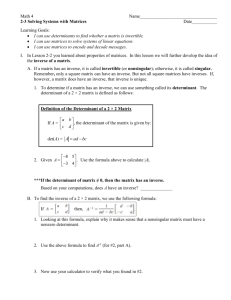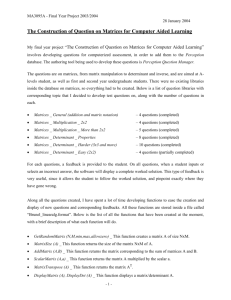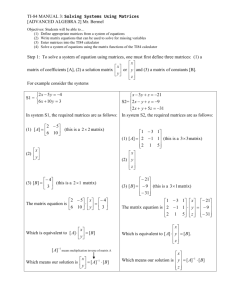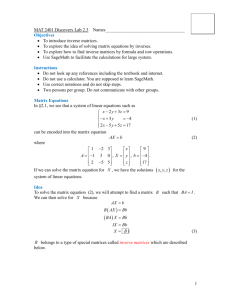Lesson 2-3: Applications of Matrices
advertisement
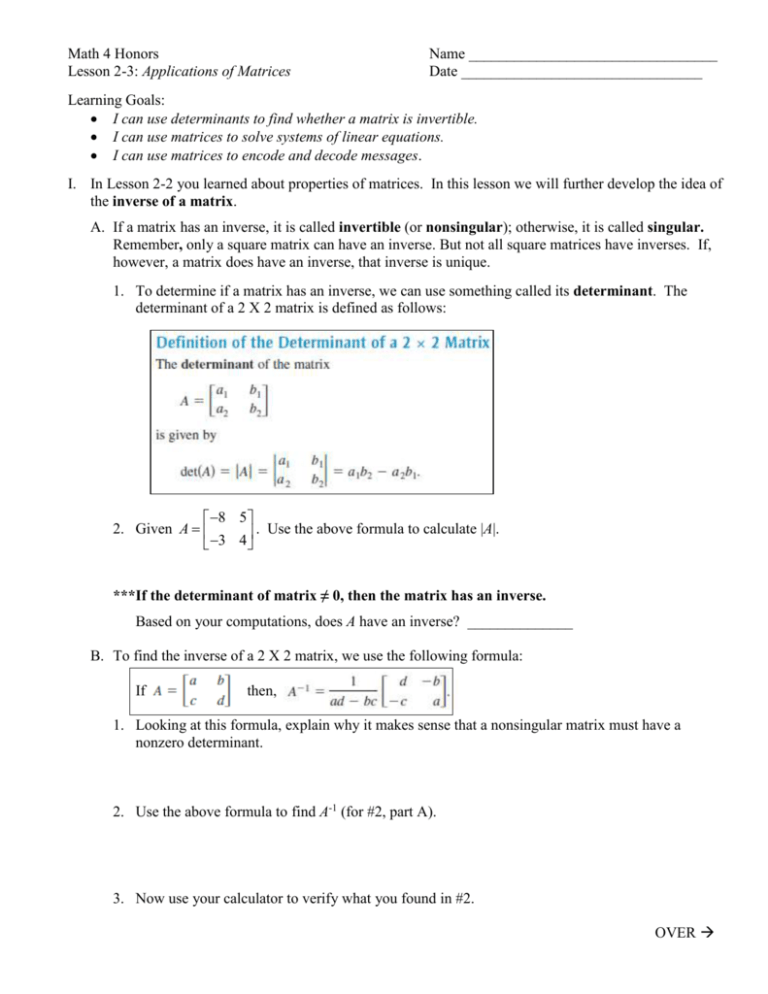
Math 4 Honors Lesson 2-3: Applications of Matrices Name _________________________________ Date ________________________________ Learning Goals: I can use determinants to find whether a matrix is invertible. I can use matrices to solve systems of linear equations. I can use matrices to encode and decode messages. I. In Lesson 2-2 you learned about properties of matrices. In this lesson we will further develop the idea of the inverse of a matrix. A. If a matrix has an inverse, it is called invertible (or nonsingular); otherwise, it is called singular. Remember, only a square matrix can have an inverse. But not all square matrices have inverses. If, however, a matrix does have an inverse, that inverse is unique. 1. To determine if a matrix has an inverse, we can use something called its determinant. The determinant of a 2 X 2 matrix is defined as follows: 8 5 2. Given A . Use the above formula to calculate |A|. 3 4 ***If the determinant of matrix ≠ 0, then the matrix has an inverse. Based on your computations, does A have an inverse? ______________ B. To find the inverse of a 2 X 2 matrix, we use the following formula: If then, 1. Looking at this formula, explain why it makes sense that a nonsingular matrix must have a nonzero determinant. 2. Use the above formula to find A-1 (for #2, part A). 3. Now use your calculator to verify what you found in #2. OVER Page 2 II. Why is the inverse of a matrix so important? You will see in this next section . . . . . A. Solving a system using the Inverse-Matrix Method: In previous courses you learned multiple methods of solving a system of equation: graphically, substitution, and linear combinations. The Inverse-Matrix Method is yet another process. 1. The Inverse-Matrix Method Matrix uses matrix multiplication to represent a system of linear equations. Note how the system can be written as the matrix equation AX = B where A is the coefficient matrix of the system, and X and B are column matrices. 2. Solving a system using matrices boils down to setting up and solving a matrix equation. Note the similarity to solving a linear equation to that of a matrix equation: 3. Let’s see how this works. Study the following example: Consider the following system of linear equations. a. Write this system as a matrix equation. A ● X = AX = B. B b. Solve the matrix equation for X. Solution Matrix X = A-1B. -1 X = ● = A-1 ● B Page 3 4. Solve the following system using the Inverse-Matrix Method. a. Write the system as a matrix equation. ● A X = B b. Use your calculator to solve the matrix equation for X. Solution Matrix: x y z B. Cryptography 1. A cryptogram is a message written according to a secret code. (The Greek word kryptos means “hidden.”) Matrix multiplication can be used to encode and decode messages. To begin, you need to assign a number to each letter in the alphabet (with 0 assigned to a blank space), as follows. Then the message is converted to numbers and partitioned into uncoded row matrices, each having n entries. OVER Page 4 2. Study the example below to see how to encode a message. To encode a matrix, create an n X n invertible matrix, such as matrix A below. Multiply the uncoded row matrices by to obtain coded row matrices. Here is an example: *** M E E encoded! Here’s the rest: So, the sequence of coded row matrices is: Finally, removing the matrix notation produces the following cryptogram. M E E T M E MO N D A Y _ Page 5 3. What do you think is involved to decode the message? How would you reverse the process? Test out your theory to decode: Show your work below. 4. Your turn . . . . . Message: GO TO HOMECOMING A. Write the uncoded 1 X 3 row matrices for the message. B. Then encode the message using the encoding matrix: C. Check your encoded message by decoding it. Show your work below. OVER Page 6 Lesson 2-3 Homework Please show your work on another piece of paper. 1. Without using a calculator, show that B is the inverse of A. 2. Without using a calculator, find the inverse of each matrix (if it exists). A= B= C= Use your calculator for the remaining problems. 3. Use the Inverse-Matrix Method to solve the following systems (if possible). You must write the matrix equation as well as your final solution matrix. a. b. c. d. e. f. Use the Inverse-Matrix Method to solve the following problems 4 – 6. 4. A serving of roast beef has 17 grams of protein and 11 milligrams of calcium. A serving of mashed potatoes has 2 grams of protein and 25 milligrams of calcium. How many servings of each are needed to get 40 grams of protein and 97 milligrams of calcium? 5. 6. 7. Write a cryptogram for the message below using the matrix A. 8. Use A-1 to decode the following cryptogram. LANDING SUCCESSFUL

